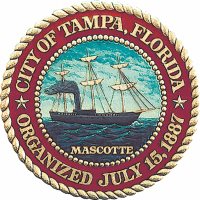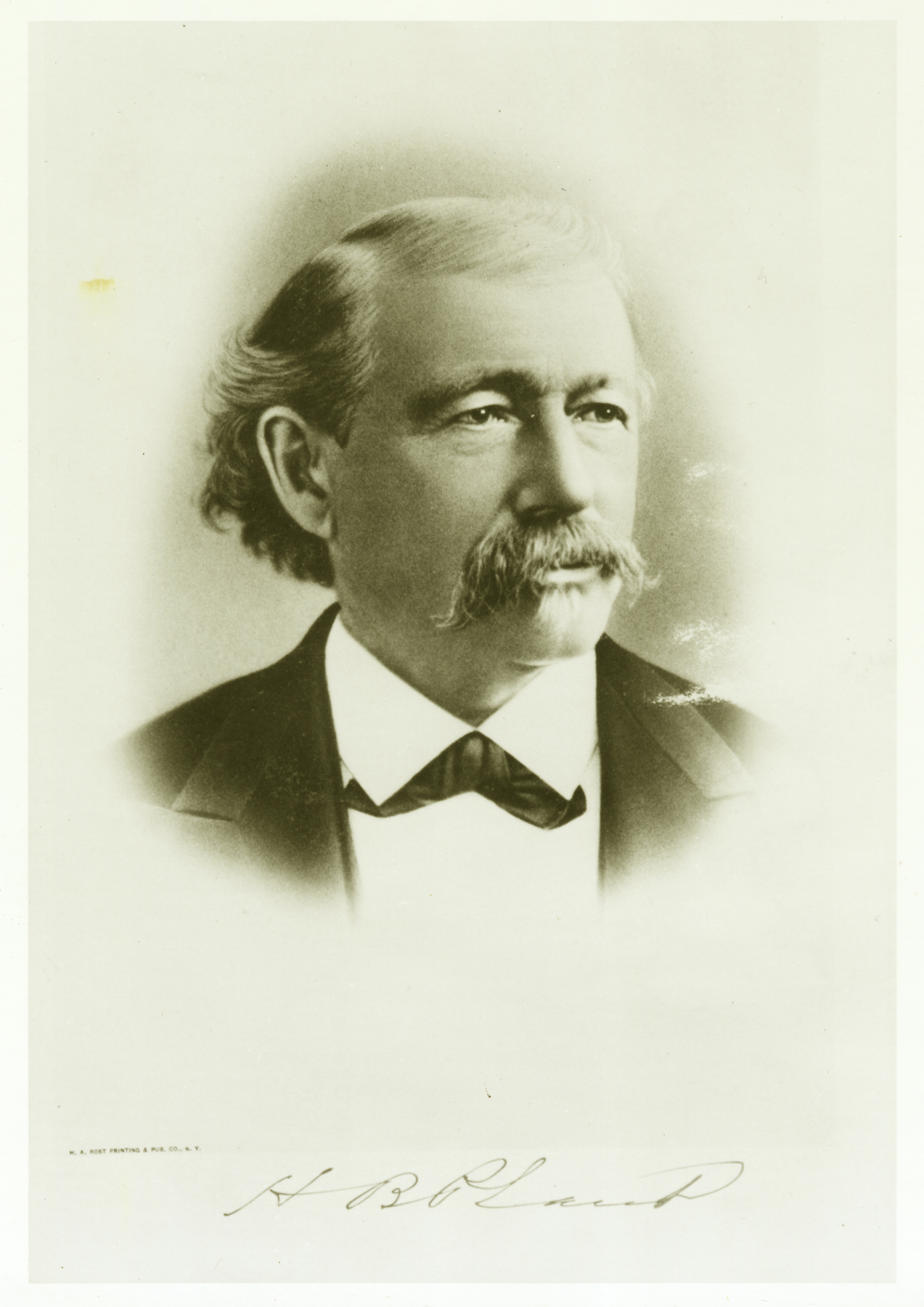 Henry Bradley Plant (October 27, 1819 – June 23, 1899), founder of the Plant System of railroads and steamship lines, was born into a modest farming family in Branford, Connecticut. At the age of six, he lost his father and younger sister to typhus fever and was raised by his mother, stepfather and grandmother.
Henry Bradley Plant (October 27, 1819 – June 23, 1899), founder of the Plant System of railroads and steamship lines, was born into a modest farming family in Branford, Connecticut. At the age of six, he lost his father and younger sister to typhus fever and was raised by his mother, stepfather and grandmother.
Henry began his professional life at a young age working as a captain’s boy for the New Haven Steamboat Company. He worked on ships running between New York and New Haven. In 1842, he married Ellen Elizabeth Blackstone. The couple had two children, but only one son, Morton Freeman Plant survived to adulthood. Plant demonstrated acuity for the express shipping business and moved up the ranks in the shipping company. He eventually secured a position in the Adams Express Company’s New York office.
In 1854, Henry and Ellen moved to Augusta, Georgia where he was placed in charge of the Adams Express Company’s southern division of express transportation, which ran throughout South Carolina and Georgia. As the rumblings of war intensified in the early part of 1861, the Adams Express Company considered their southern holdings. Plant organized some investors and proposed that he purchase the Adams Express Company’s southern lines. An agreement was reached and Plant reorganized the division as the Southern Express Company. It was the first company Plant purchased. In that same year, Ellen succumbed to tuberculosis.
After the Civil War, Plant returned to New York. In 1873, he married Margaret Josephine Loughman. He immersed himself in his work, investing in railroads and cultivating professional connections with financiers and railroad men. In 1879, he purchased his first railroad, the Atlantic & Gulf in Savannah, Georgia. He reorganized the line as the Savannah, Florida & Western Railway, with a branch leading to Live Oak, Florida. As he purchased more rail lines and linked them throughout the southeast, he began to work his way into Florida. He opened the Waycross Short Line in 1881, a short cut from Waycross, Georgia to Jacksonville, Florida. Plant recognized Florida’s economic potential, and understood that a continuous network of railways was the key to unlocking it.
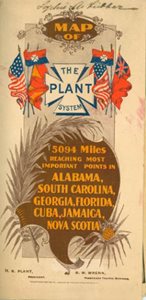 In 1882, Plant formed the Plant Investment Company (PICO) headquartered in Sanford, Florida. With the investment support of PICO, whose investors included Henry Flagler, M.K. Jesup, and W.T. Walters, Plant acquired existing rail lines and laid new track into central and western Florida. He purchased the contract to build the vital stretch of the Jacksonville, Tampa, Key West line from Kissimmee to Tampa in 1883. When he successfully completed the 70 miles of new track in early 1884, Tampa became connected to the rest of the eastern seaboard. As he linked and laid more than 1,196 miles of tracks across the state, he replaced the inconsistent wide and narrow-gauge tracks with standard gauge, increasing ease and efficiency of train travel.
In 1882, Plant formed the Plant Investment Company (PICO) headquartered in Sanford, Florida. With the investment support of PICO, whose investors included Henry Flagler, M.K. Jesup, and W.T. Walters, Plant acquired existing rail lines and laid new track into central and western Florida. He purchased the contract to build the vital stretch of the Jacksonville, Tampa, Key West line from Kissimmee to Tampa in 1883. When he successfully completed the 70 miles of new track in early 1884, Tampa became connected to the rest of the eastern seaboard. As he linked and laid more than 1,196 miles of tracks across the state, he replaced the inconsistent wide and narrow-gauge tracks with standard gauge, increasing ease and efficiency of train travel.
Rail travel wasn’t Plant’s sole focus. Plant knew that convenient transportation in Florida required water access and connections. He purchased the People’s Line of Steamboats that sailed along Florida’s rivers. But Plant had a vision to establish a continuous means of travel from the north to Cuba. By 1890, he began to develop the Plant Steamship Line sailing between Boston, Halifax, Cape Breton and Prince Edward Island. Plant’s international transportation empire was taking shape.
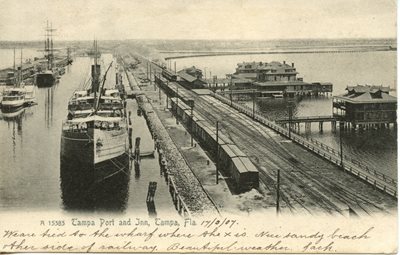 Plant’s goal was to connect his rail lines to a port terminus in Florida. Tampa emerged as the ideal location. Plant extended his rail line from Tampa to Port Tampa, dug out the channel, extended the dock, and built up the port to accommodate steamships and their high volume of traffic. By 1889, the deep-water terminal secured Port Tampa’s position as a major transportation hub in the Western Hemisphere. These improvements allowed the Plant Line to sail from Tampa to Havana, Mobile, and Jamaica. Plant secured the U.S. mail contract for the West Indies route between Port Tampa, Key West, and Havana. Plant had his port to access the Gulf and Caribbean.
Plant’s goal was to connect his rail lines to a port terminus in Florida. Tampa emerged as the ideal location. Plant extended his rail line from Tampa to Port Tampa, dug out the channel, extended the dock, and built up the port to accommodate steamships and their high volume of traffic. By 1889, the deep-water terminal secured Port Tampa’s position as a major transportation hub in the Western Hemisphere. These improvements allowed the Plant Line to sail from Tampa to Havana, Mobile, and Jamaica. Plant secured the U.S. mail contract for the West Indies route between Port Tampa, Key West, and Havana. Plant had his port to access the Gulf and Caribbean.
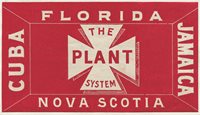 Plant branded his network of railroads and steamship lines The Plant System. The Plant System was the most profitable transportation network in Florida during the 1880s and 1890s, connecting Florida producers with Eastern seaboard consumers. Industries such as citrus, celery, lumber and phosphate flourished across the state as The Plant System provided rapid, mass transportation of goods. Plant’s network of railroads and steamships enticed many industries to Tampa, most notably Vicente Martinez Ybor and the cigar industry.
Plant branded his network of railroads and steamship lines The Plant System. The Plant System was the most profitable transportation network in Florida during the 1880s and 1890s, connecting Florida producers with Eastern seaboard consumers. Industries such as citrus, celery, lumber and phosphate flourished across the state as The Plant System provided rapid, mass transportation of goods. Plant’s network of railroads and steamships enticed many industries to Tampa, most notably Vicente Martinez Ybor and the cigar industry.
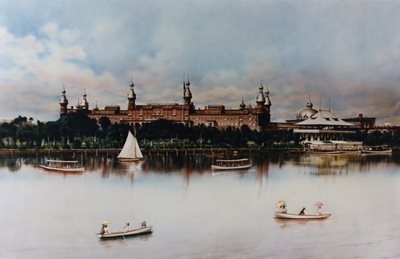 Thanks to the Plant System, Florida’s young tourism industry boomed. Plant established eight hotels throughout western Florida that provided tourists with luxury accommodations and first-class amenities in a tropical haven. Plant opened his first hotel in 1888, the Inn at Port Tampa. He quickly followed with the Kissimmee Hotel in 1890, the Tampa Bay Hotel and the Seminole in 1891, the Punta Gorda Hotel in 1894, Hotel Belleview in 1895, and Ocala House and Fort Myers Hotel in 1898. His grandest and most opulent hotel was the Tampa Bay Hotel. The Plant System published thousands of promotional materials advertising Florida as a tourist destination.
Thanks to the Plant System, Florida’s young tourism industry boomed. Plant established eight hotels throughout western Florida that provided tourists with luxury accommodations and first-class amenities in a tropical haven. Plant opened his first hotel in 1888, the Inn at Port Tampa. He quickly followed with the Kissimmee Hotel in 1890, the Tampa Bay Hotel and the Seminole in 1891, the Punta Gorda Hotel in 1894, Hotel Belleview in 1895, and Ocala House and Fort Myers Hotel in 1898. His grandest and most opulent hotel was the Tampa Bay Hotel. The Plant System published thousands of promotional materials advertising Florida as a tourist destination.
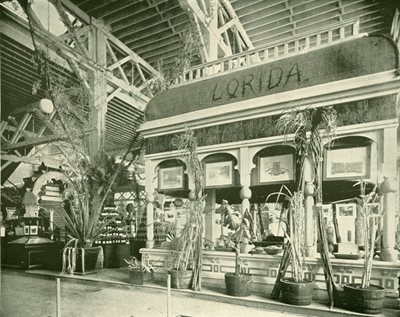 Henry Plant encouraged Florida’s economic growth as he promoted the state’s attributes at world’s fairs and expositions. He constructed displays of Florida’s goods in Paris during the Universal Exposition in 1889, in Chicago at the World’s Columbian Exposition in 1893, in Atlanta at the Cotton States and International Exposition in 1895, and in 1897 at the Tennessee Centennial and International Exposition in Nashville.
Henry Plant encouraged Florida’s economic growth as he promoted the state’s attributes at world’s fairs and expositions. He constructed displays of Florida’s goods in Paris during the Universal Exposition in 1889, in Chicago at the World’s Columbian Exposition in 1893, in Atlanta at the Cotton States and International Exposition in 1895, and in 1897 at the Tennessee Centennial and International Exposition in Nashville.
In 1898, Plant catapulted Tampa, and the Tampa Bay Hotel, onto the international stage. As the United States government was developing plans to invade Cuba during the Spanish-American War, Plant sent Franklin Q. Brown to Washington to present the argument that Tampa should be the port of embarkation for the military campaign. Due to the Plant System’s development of the railroad, port, and Hotel, Tampa was selected. The Tampa Bay Hotel became the headquarters for the U.S. Army, housing officers, foreign dignitaries, war correspondents, and Red Cross personnel.
Plant passed away on June 23, 1899 from a heart attack. He was 79 years old. Plant’s significant contributions to the development of Florida and Tampa Bay inspired Success magazine to name Henry Plant “the King of Florida” in 1898. At that time, no other person had dedicated as much time, energy, and money to the advancement of Florida. Plant’s legacy was foreshadowed by J. W. Fitzgerald in 1895 when he stated, “The Plant System…a monument to [Plant’s] memory [is] more lasting than brass and more enduring than marble.”
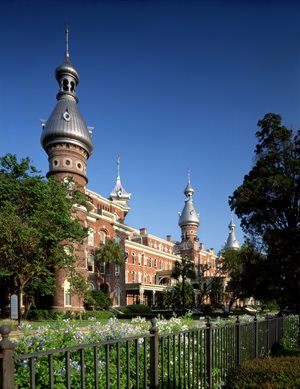 Much of Plant’s legacy can be seen today. Cities such as Plant City, Sanford, Auburndale, Trilby, and Port Tampa attribute their development to Henry Plant. Streets in Tampa, Port Tampa, and Waycross, GA bear the names of Plant family members and Plant System officers. Waycross, Georgia has a Plant Park. Many of the Amtrak and CSX rail lines that run through Tampa use the original Plant System rail line footprint. H. B. Plant High School opened in 1926. Morton Plant Hospital, the first hospital in northern Pinellas County, was named for Plant’s son. The City of Tampa seal bears a rendition of Plant’s steamship the Mascotte. The former Tampa Bay Hotel garden, known as Plant Park and Tampa’s first public park, continues to offer a relaxing, natural refuge along the Hillsborough River. The former Tampa Bay Hotel is the only Plant System hotel still standing in its entirety and the minarets have become the premiere architectural icon of the City of Tampa.
Much of Plant’s legacy can be seen today. Cities such as Plant City, Sanford, Auburndale, Trilby, and Port Tampa attribute their development to Henry Plant. Streets in Tampa, Port Tampa, and Waycross, GA bear the names of Plant family members and Plant System officers. Waycross, Georgia has a Plant Park. Many of the Amtrak and CSX rail lines that run through Tampa use the original Plant System rail line footprint. H. B. Plant High School opened in 1926. Morton Plant Hospital, the first hospital in northern Pinellas County, was named for Plant’s son. The City of Tampa seal bears a rendition of Plant’s steamship the Mascotte. The former Tampa Bay Hotel garden, known as Plant Park and Tampa’s first public park, continues to offer a relaxing, natural refuge along the Hillsborough River. The former Tampa Bay Hotel is the only Plant System hotel still standing in its entirety and the minarets have become the premiere architectural icon of the City of Tampa.
